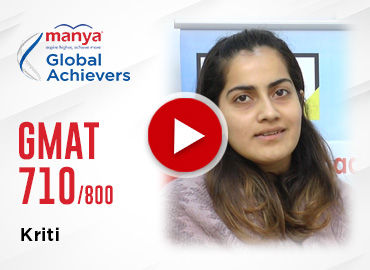GMAT Focus Edition
The overall message seems to be a shorter test, focused on business skills to help students apply to business school and boost career success faster! Some could say this is a way to lessen the GMAT to fall more in line with the GRE, which continues to take market share away from the GMAT.
Summary of Changes
-
- 3x 45-minute sections, no essay, and reduced content to prep.
- One hour less; the shortest GMAT test ever!
- Reduced content which means less content to prep!
- No essay section; all questions will be multiple-choice
- After you know your score, send it to five schools for free!
- Three sections only focused on business relevant business skills.
- Personalized performance on relevant business skills.
- You can go in and change three questions per section.
- Self-select section order.
- More focused sections.
Part 2
The GMAT Exam- Focus Edition launched on August 29, 2023, and will run concurrently with the existing GMAT exam until January 31, 2024. During this time, candidates have the choice to register for either exam or both.
GMAC has released additional information on test.
- Test prep materials is launched. You can find it on MBA.com..
- Test registration for focus edition is open now.
There will be 3 sections. Each section is 45 minutes.
- Verbal — 23 Questions — Critical Reasoning & Reading Comp (Yes, that’s right, no more misplaced modifiers or pronoun errors. Sentence correction will be a thing of the GMAT past.)
- Quant — 21 Questions — No more geometry and no data sufficiency in Quant
- Data Insights — 20 Questions — IR and Data Sufficiency (likely 12 IR and 8 DS)
- Test-takers will be able to bookmark questions as they proceed through each section.
- At the end of the section–provided that there is time remaining–the test-taker sees a review and edit screen.
- From there, it’s possible to navigate back to both bookmarked and non-bookmarked questions. (That sounds like that other test that starts with a GRE!!)
- Test-takers can change their answer to up to 3 questions per section.
Part 3
Here are some of the most important things to know:
- Registration and testing for GMAT Focus in now started.
- The scale for the GMAT Focus is
– Overall Score: 205-805 in 10-point increments. Overall scores for GMAT Focus end in a 5. GMAC is doing that to help admissions directors easily distinguish between scores for the current version of the test and the GMAT Focus
– Subscores: 60-90 in 1-point increments. It is now confirmed that there will be subscores. Note that all 3 sections of the exam–Quant, Verbal, and Data Insights–contribute equally to the Overall Score. - While GMAC is discouraging test-takers and schools from comparing the two scores because the tests are different, they have also released a score concordance. Based on the concordance, 645 is the new 700! It doesn’t quite have the same cachet, does it?
- With GMAT Focus comes an enhanced score report that includes more information about how test-takers performed on different question types and content. It also includes comparison information about how the test-taker performed versus others who have sent their scores to that same program or school in the last 5 years. Basically, every test-taker now gets an even more enhanced version of what GMAC used to sell as the enhanced score report.
- GMAC is also doing away with the need to cancel scores! With the launch of GMAT Focus, students have more flexibility about when they can choose the schools to send scores to and they can choose which scores to send. So, there’s no need to cancel. Students should really like this feature of the new test!
Complete Write-Up on GMAT Focus Edition
In this blog, you will learn all we know about the new GMAT Focus Edition so far. We explain how it is different from the current GMAT, such as how the verbal, quantitative, and integrated reasoning sections have changed.
What Is the GMAT Focus Edition?
This newer version of the GMAT—GMAT Focus Edition—is, according to GMAC, “a more focused test-taking experience that hones in on the higher-order critical reasoning and data literacy skills that are especially relevant and applicable in the business environment of tomorrow.”
Even after the changes, which will be discussed in depth in this blog, the GMAT will still be a standardized test that business schools use to assess the skills of MBA and EMBA aspirants.
So, the essential goal of the GMAT remains unchanged. The skills you currently need to demonstrate well on the current GMAT will essentially be the same on the GMAT Focus Edition. The GMAT Focus Edition syllabus will cover these skills in detail.
When Is the GMAT Focus Edition Scheduled To Be Rolled Out?
The GMAT Focus Edition testing is started from November 7, 2023. The Official Prep is already live on MBA.com, and registration is open for candidates interested in taking the exam.
If you are currently preparing for the GMAT, do not worry! The current edition of the GMAT and current GMAT official materials, such as official practice tests, will be accessible until January 31,2024. So, those who are currently preparing for the GMAT and have upcoming business school application deadlines will not have their plans delayed or disrupted.
How is the GMAT Focus Edition Different from the Current GMAT Edition?
Let’s skim through the variations in structure and content between the GMAT Focus Edition and the current GMAT.
Format Changes
With the upcoming Focus Edition, the GMAT’s format will undergo significant changes.
Test Time
One of the most significant changes to the GMAT is the duration of the test. The GMAT Focus Edition is just 2 hours and 15 minutes long (excluding breaks), while the current GMAT is 3 hours and 7 minutes long (excluding breaks).
Thus, the GMAT Focus Edition is approximately 1 hour shorter than the current GMAT.
See the table below for a breakdown of GMAT Focus Edition timing by section and question:
| GMAT Focus Edition Structure | |||
| Quantitative Reasoning | Verbal Reasoning | Data Insights | |
| Section Time | 45 minutes | 45 minutes | 45 minutes |
| No. of Questions (64) | 21 | 20 | 23 |
| Question Types | Problem Solving
*May be Data Sufficiency is excluded |
Critical Reasoning Reading Comprehension *May be Sentence Correction is excluded |
Data Sufficiency Multi-Source Reasoning,Table Analysis,Graphics Interpretation,Two-Part Analysis |
| Av. Time Per Question | 2 minutes 9 seconds | Appx. 2 minutes | 2 minutes 15 seconds |
| Total Time | 2 hours 15 minutes | ||
Section Order Choice
Choosing section order will be more flexible in the GMAT Focus Edition—another welcome step. In contrast to the current GMAT, where you have three options for section order, the GMAT Focus Edition will let you take the three sections in whatever order you wish.
So, instead of the three options you have now, you’ll have six: you can choose any order from Data Insights (DI), Quantitative Reasoning (QR), and Verbal Reasoning (VR).
Adaptability
The most significant change to the adaptive nature of the test is that all three sections of the Focus Edition are adaptive. So, the Data Insights (DI) section, which is called Integrated Reasoning (IR) on the current GMAT, will also be adaptive. The Verbal and Quantitative sections will, of course, also be adaptive.
Question Review and Edit
One cool new thing about the GMAT Focus Edition is that you can go back and change your answers in each section.
However, this functionality is no longer unlimited. The GMAT Focus Edition continues to be a question-adaptive test. For the scoring system to function, then, the majority of your responses in a section must stay unaffected. So, you can change up to three responses in each section.
In addition, in each section, you may review your responses to as many questions as you want; the bookmarking option allows you to mark as many questions as you like so that you can simply return to them later.
So, let’s say you bookmarked six questions in a section because you were uncertain of your responses. Understanding that you can only change responses to 3 questions, you could, if time allows, revisit and review them, then decide which 3 responses need to be changed.
Scoring
The GMAT’s scoring system will also undergo a significant change. In addition to your Quantitative and Verbal scores, your Data Insights (DI) score, which substitutes for Integrated Reasoning (IR), will contribute equally to your GMAT Total Score. As you may be aware, the IR section of the current GMAT is scored separately and does not contribute to your GMAT Total Score.
Scores on the GMAT Focus Edition also look a little different. Each section is scored on a scale of 60–90 with 1-point increments, and the Total Score is on a scale of 205–805 with 10-point increments.
| GMAT Focus Edition Scoring | ||
| Scale | Increments | |
| Quantitative Reasoning | 60-90 | 1 |
| Verbal Reasoning | 60-90 | 1 |
| Data Insights | 60-90 | 1 |
| Total Score | 205-805 | 10 |
Hence, the maximum possible score on the GMAT Focus Edition is 805, as opposed to 800 on the current GMAT. Since Integrated Reasoning (IR) is no longer a part of the Focus Edition, its 0–8 score is irrelevant.
Reporting of Score
With the new edition of the GMAT, score reporting is also being updated, and test-takers will certainly benefit from the changes.
With the GMAT Focus Edition, like with the current GMAT, test-takers will be able to send their scores to up to five schools for free.
In addition, any Official Score Report you send will only include a single and the latest GMAT score, not your entire GMAT score history. So, after taking the GMAT Focus Edition and seeing your score, you can decide to send it to a few colleges (five) for free. The schools you select on your test day will only see your score from the most recent test you took, not your scores from the previous five years.
Hence, you are not required to disclose past results to colleges if you choose not to.
Enhanced Score Report
Currently, test-takers may ask for an Extended Score Report (ESR) for $30 after taking the GMAT. The ESR provides more information on the test’s performance across the many test sections and question types than is available on the normal score report.
With the GMAT Focus Edition, test-takers do not need to apply for an ESR in order to get this sort of performance data. Instead, each GMAT test-taker will get “personalized insights” about their performance in a full and expanded score report that is provided with GMAT registration.
Now that we know how the GMAT Focus Edition is different from the current GMAT in terms of structure, let’s explore the changes in content.
Changes in Content
The majority of the GMAT Focus Edition’s content will be the same as what the current GMAT covers. Nonetheless, there are significant changes to be aware of in all sections of the test. Let’s begin with a massive change: the GMAT essay.
AWA
The GMAT Focus Edition will not have an essay section. So, unlike the current GMAT, all questions on the new GMAT will be multiple-choice.
Since the AWA takes up 30 minutes of the current GMAT’s test time, its removal from the GMAT Focus Edition is one of the reasons why the new GMAT is shorter.
Quants
The Quantitative section of the GMAT Focus Edition retains the Problem-Solving problems that the current GMAT has. Nevertheless, the GMAT Focus Edition Quant section will no longer contain Data Sufficiency problems, which is a significant shift. Data Sufficiency is moved to Data Insights (DI) section.
Nonetheless, it looks like the topics covered in the Quantitative section will stay essentially the same.
All topics that the current GMAT quant section covers are retained in the Focus Edition. Yet, the list misses one key topic: Geometry. It looks like Geometry will no longer be included in the Quant section.
As Geometry does not feature on the Executive Assessment (EA), which the GMAT Focus Edition mimics in numerous respects, the absence of Geometry from the GMAT Focus Edition does not surprise us.
Verbal
Comparing the current GMAT to the GMAT Focus Edition, the Verbal section has seen the most significant changes. The Verbal section of the GMAT Focus Edition will consist only of Reading Comprehension (RC) and Critical Reasoning (CR). Thus, the Verbal section will not feature Sentence Correction (SC).
In the current GMAT, about one-third of the Verbal section is comprised of Sentence Correction problems. Many GMAT test-takers find Sentence Correction to be the simplest sub-section of the Verbal section, both in terms of their knowledge of the content and their ability to answer problems correctly. So, the absence of Sentence Correction makes the Verbal section look more difficult than ever for some test-takers.
Integrated Reasoning (IR)—Transforming into Data Insights (DI)
In contrast to the Verbal and Quantitative sections, which are both reducing, the GMAT’s Integrated Reasoning section is broadening and is renamed Data Insights.
The Data Insights (DI) section of the GMAT Focus Edition has the same Multi-Source Reasoning (MSR), Table Analysis (TA), Graphical Interpretation (GI), and Two-Part Analysis (2PA) problems that feature on the current GMAT’s Integrated Reasoning section. In addition, the DI section will contain the Data Sufficiency problems that have traditionally been included in the Quant section.
Consequences of the Content Changes
GMAC claims the GMAT Focus Edition to be “more efficient” and “more focused” on pertinent business skills than the current GMAT. The omission of Geometry and Sentence Correction has reduced the number of topics on the GMAT, as is evident. Thus, there may be less content to study.
The relocation of Data Sufficiency to the Data Insights section will likely have little effect on test-takers. Students will still need to understand the ideas and techniques necessary to answer Data Sufficiency questions, which we do not anticipate changing much, if at all.
According to GMAC, the GMAT Focus Edition will examine data analytic abilities in novel ways. It is unknown what this information signifies for the Data Insights section and whether its questions will be identical to Integrated Reasoning questions.
Even with the modifications, studying for the GMAT Focus Edition will require a great deal of time, effort, and commitment.
Major Differences Between the GMAT Focus Edition and the Current GMAT
| GMAT Focus Edition Scoring | ||
| Current GMAT | GMAT Focus Edition | |
| Total Test Time (ext. breaks) | 3 hours 7 min. | 2 hours 15 min. |
| No. of Sections | 4 | 3 |
| Section Types | AWA, IN, Quant, Verbal | Data Insights, Quant, Verbal |
| Question Types | AWA: Essay; IR: MSR, TA, GI, TA;
Quant: PS, DS; Verbal: SC, CR, RC |
DI : DS, MSR, TAS GI, TA ; Quant : PS ; Verbal : CR, RC |
| Time Per Section | AWA: 30 min.; R: 30 min.; Quant: 62 min.; Verbal: 75 min. | DI: 45 min.; Quant: 45 min.; Verbal: 45 min. |
| Time Per Question | AWA: 30 min.; IN: 230 min.; Quant: 2 min.; Verbal: 1 min. 48 sec. |
DI : 2 min. 15 Sec. ; Quant : 2 min. 9 Sec. ; Verbal : 2 min. |
| Review and Bookmarking | No | Yes (edit up to 3 responses) |
| Section Order Choices | 3 | 6 |
| Section Score Range | 6-51 | 60-90 |
| Total Score Range | 200-800 | 205-805 |
| Score Reporting | Select five schools before seeing score; schools see all previous scores | Select five schools after seeing score; schools do not see previous scores |
| Enhanced Score Report (ESR) | $30 | Free |
Key Takeaways
- The GMAT Focus Edition is about an hour shorter than the current GMAT.
- The GMAT Focus Edition testing is started from November 7, 2023.
- The current GMAT consists of four sections; however, the GMAT Focus Edition comprises only three: Quantitative, Verbal, and Data Insights.
- Unlike the current GMAT, in which the Total Score consists of scores from only two sections Quantitative and Verbal, the Total Score for the GMAT Focus Edition will consist of scores from all three sections Quantitative, Verbal, and Data Insights.
- Content-wise, the GMAT Focus Edition is virtually identical to the current GMAT, with the exception of Geometry and Sentence Correction.












